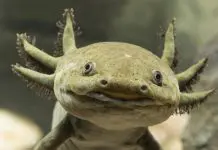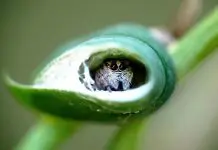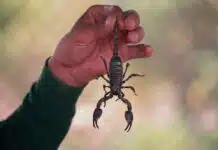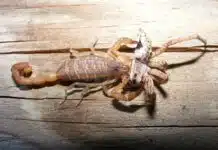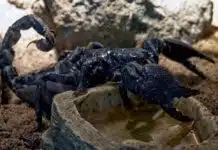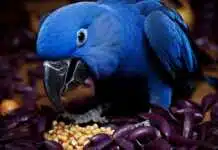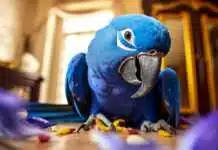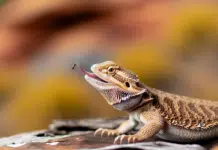What will you feed them with if you have a jumping spider as a pet?
Before you decide, let’s look into detail jumping spiders’ diet for both found in the wild and those in captivity.
Jumping spiders eat insects like crickets, moths, and flies. They generally eat anything from insects to bugs or anything that moves. That includes their own kind as well.
Despite their carnivorous nature, you might find some species of jumping spider to consume nectar and pollen as part of their diet too. Bet you didn’t know jumping spiders to be semi-vegetarian right…?
Jumping spiders in the wild – What do they eat?
As I have mentioned, they eat pretty much everything that moves within their habitat. They generally prey on insects or bugs that are smaller in size. Even though there are instances where they go after prey that are larger than them.
So depending on the habitat that they live in, they tend to go for insects living within that habitat. Take for example The Phidippus audax or bold jumping spider found in cotton fields tend to go for Anthonomus grandis or Lygus lineolaris aka tarnished plant bug which can be found in cotton fields.
How do they hunt?
Jumping spiders are known for their leaping capabilities. They don’t really spin webs to catch their prey but rather prowl on tall grasses or leaves for bird’s eye view of the insects roaming on the earth. From here you can guess that their ability to stalk their prey from above is also possible due to their incredible eyesight and vision.
They will target creatures that are smaller than them from above before lunging at their prey. Once they catch a hold of their prey, they will bite them and inject their venom causing them to be paralyzed.
Jumping spider in the captivity – What should I feed them with?
Well, the answer is simple. Find insects that can be found online. And buy a bulk of them. Or just catch some in your house.
#1 Suitable food source for your pet spider
Crickets
Crickets can be found anywhere. You can probably find a bunch of them living in your yard or garden. They are smaller in size so they are much preferable as your pet spider’s meal.
Pros
- Very easy to find at home and in stores
- Small crickets are great live prey for your jumping spider
Cons
- Large crickets may bite – generally go for crickets that are no bigger than 1.5x of your spider
Crickets, in general, are suitable for spiders of all ages from juvenile to adult and even old spiders. Just make sure they are not too big for your spiders. For older spiders, they are not so active so make sure you kill the cricket for them first before feeding them.
How to catch crickets?
Problem with crickets is that they are really agile. So it going to take some time to catch them by hand without hurting them. So here is a step by step guide to creating a cheap but useful trap:
Bottle trap method
Items required:
- 1.5L bottle
- Some tape
- Scissors
Step by step guide:
Step 1: Remove the cap of the bottle.
Step 2: Cut the top 25% of the bottle, at the shoulder. Now the bottle will be in 2 parts: the shoulder and main body.
Step 3: Put some fruits into the bottom of the bottle’s main body.
Step 4: Invert the shoulder of the bottle facing down into the body of the bottle. And tape up the edges.
Step 5: Lie the bottle down in your backyard or anywhere that you know crickets are active.
Step 6: lay a piece of wood to create a path for crickets to enter the bottle’s neck.
Step 7: Leave it overnight and check your bottle the next day to see if there are crickets in there.
This method will get you a steady supply of crickets from your backyard. But it is still better to just purchase a bunch of them from a pet shop or online stores so that you won’t have to always catch them.
Where to buy crickets? – cost and quantity
Live crickets that are ¼ or ½ of an inch are recommended for smaller jumping spiders. They only cost about $13 to $25 depending on how many you buy at once. They usually come in a pack of 1000 which can be a lot for your spiders.
Just like mealworms, if you have other exotic pets too it will be a good idea to breed your own crickets for an everlasting supply of food.
Moths
Within your house, when there are lights – then there are… Moths! This is especially so if you are living in tropical countries or in the summer.
Pros
- Moths can be found at home. Homemade traps can be easily crafted to catch moths
- Great preys for jumping spiders as they don’t bite
Cons
- Depending on where you live, there might not be enough moths for the amount of your spiders’ intake.
Moths can be fed to both adult and juvenile spiders. For older spiders, you may have to kill the moths for them as they won’t jump around hunting them.
How to catch moths?
Moths are nocturnal creatures so they are very active in the night. They are particularly attracted to light which makes our first method really easy:
Method 1: Using light
The light method is a very effective and cheap way to attract moths. But wait for them to appear can be time-consuming.
Items required:
- Really bright lamp or light source
- White sheet
- Butterfly/moth net is not compulsory but very useful
- Container
Step by step guide:
Step 1: Lay a white sheet
Step 2: Turn off the room’s light or dim it down.
Step 3: Turn on the light source – lamp or led lights.
Step 4: Wait for them to turn up
Step 5: Then use moth net or your hands to catch them. Put them into a container.
Method 2: Using bait
The bait method is cheap and uses everyday materials to concoct a solution or mixture that are very effective in attracting moths. The downside is that it can attract other insects or worse, animals.
Items required for recipe 1:
- Overripe bananas or apples
- Molasses
- Brown sugar
- Beer (stale beer is preferable) or apple cider
- Bowl
- Container
Recipe 1 Step by step guide:
Step 1: Add 1.5 cups of brown sugar, a ½ cup of molasses and a can beer/apple cider along with fruits you prepared into a blender. Yeast is optional.
Step 2: Blend them up and put them into a bow.
Step 3: Leave it in the open and wait for moths to appear
Step 4: Catch them with your hands or moth net and gently transfer them into a container.
Items required for recipe 2 (simpler method):
- Brown ale or beer
- Black treacle
- Sugar
- Small brush
- Bowl
- Container
Recipe 2 Step by step guide:
Step 1: Add a ½ pint of brown ale or beer, 2 tablespoons of black treacle and good amounts of sugar into a pot.
Step 2: Pot at low heat. Simmer the mixture
Step 3: Make sure it turns out sticky with a thicker consistency
Step 4: Transfer mixture to a bowl
Step 5: Using the brush, apply the mixture on tree branch or surface to attract moths
Step 6: Wait for the moth to appear
Step 7: Use a moth net to catch it and transfer them into a small container
To get a steady supply of moth as a food source for your spider, it is better to use an actual moth trap that can be purchased either online or pest shops. Make sure to only get traps that don’t kill your moths as your spider will like them fresh.
So do you think if moths are a great choice of food?
Before making that decision let’s look at another alternative food source.
Flies
Head to your kitchen, see any fruit flies around? Or if you are feeling adventurous and have a lot of time on your hands, try catching a house fly (green-blue bottle fly). These are 2 common files that are a great source of food for your pet spiders.
Pros
- Both flies are a great source of nutrients – Spiders love them
- Can be kept a long time in the fridge
- Can be found at home easily
Cons
- Fruit flies are generally small so they might not be filling enough for adult spiders
- Green and blue bottle flies are generally difficult to catch
- Without refrigeration, they may lay eggs and into more maggots
Fruit flies are more suitable for juvenile spiders or spiderlings while green and blue bottle flies are great for adult spiders.
You can keep flies refrigerated to ensure their freshness. When flies are refrigerated, they go into a state of torpidity. This makes feeding easier as they do move at all.
How to catch files?
Best way to catch flies is to create traps and wait for them to fall into it. I have some examples of effective traps here that can be “DIY-ed” on our own to lure files for our spiders:
Method 1: Bottle trap method
This method is very similar to the cricket bottle trap method where the bottle is cut and filled with food to lure flies. This is how it works:
Items required:
- 1.5L bottle
- Some tape
- Scissors
- Penknife
- Drill or an awl
- Bait – Can be anything sweet or edible
Step by step guide:
Step 1: It is to make a hole in the bottle cap that is about ¼ of an inch big. You can use a drill or an awl to puncture a hole. Then twist and turn the awl to make the hole to the right size.
Step 2: Remove the cap. Lie the bottle down, use the pen knife to create an opening right at the shoulder of the bottle.
Step 3: Use scissors to cut through the opening you created with the penknife. Your bottle should now be in 2 parts: The main body and the shoulder of the bottle.
Step 4: Place the bait into the bottom of the bottle’s main body. Bait can be anything from meat or fish, raw or cooked.
Step 5: Place the cap back on the bottle.
Step 6: Invert the bottle shoulder that you cut out earlier and insert it into the main body.
Step 7: Use tape to secure both pieces together.
Step 8: Leave the bottle in the open for several hours or overnight. Come back later to see if files are trapped.
Note that the bait will start to turn bad. So it is advisable to get rid of it and change a new trap every few days. This method alone should get you a steady supply of flies for your pet spider.
Method 2: Jar trap method
This method is a quick and simpler way if you don’t have any bottles lying around. Simply use a glass cup or jar is fine.
Items required:
- Jar or glass (best to be transparent)
- Fruit Slices
- Apple vinegar
- Plastic wrap
- Rubber bands
- Bait – either raw meat or fruit sliced into pieces
- Toothpick, pen or pin or needle or anything small and sharp
Step by step guide:
Step 1: Pour apple vinegar into to jar or glass
Step 2: Add in raw fruit or meat as bait
Step 3: Airtight the opening of the glass or jar with the plastic wrap. Secure with rubber bands
Step 4: Use sharp item like a toothpick to poke a few small holes on the top of the plastic wrap.
Step 5: Leave in the open and wait for files to enter
Mealworms
Mealworms are another safe source of food for spiders as they do not bite. They are also a delicious alternative for your pet spiders.
Advantages
- Great source of nutrients
- Can be easily bought from online stores or pet shops
- Easy to raise or cultivate
Disadvantages
- Leftover mealworms have to be removed or they turn into beetles. Beetles shell is hard and not suitable for jumping spiders
Mealworms are generally for adult spiders. Though they can be fed to juvenile spiderlings too as they are harmless.
Where to buy mealworms? – Cost and quantity
Live mealworms only cost about $14 to $15 for a count of 1000 mealworms. The only problem is they come in huge quantities and if you can’t feed them fast enough some will die and some will turn into beetles. You can keep them refrigerated to slow down their metamorphosis or keep them alive longer.
It takes them medium sized mealworms about 5 to 6 weeks to pupate while larger sized mealworms only take about 3 weeks.
You can also keep half of them as food and another half to cultivate your own mealworms. Once they become beetles, they can be raised to lay eggs again to produce more mealworms.
However, this will only be feasible if you have other exotic pets like salamanders, frogs or hedgehogs as pets too otherwise your pet spider wouldn’t be able to finish all the food.
Check out reliable mealworm sellers here.
All these mentioned are easy to catch food source for your pet jumping spider. If you feel that you don’t have the time to find food for them, you can always buy them online or at pet stores.
#2 Water for your pet jumping spider
Just like all animals, you spiders have to drink. It is important not to pour or add too much water into the tank or your spiders will drown.
Jumping spiders have book lungs, which are lungs that literally look like pages of a book. You do not want the water to leak into their lungs, filling them up with water can kill them. You do not need a drinking dish or puddle for them, just 1 to 2 drops of water.
Here are some ways you can do it:
- Using a mini turkey baster, drip only 1 drop into your spider cage or container. Do not drip it over your spider but at the side.
- Using a spray bottle to mist the container. Once again you do not need to spray a lot but just 1 or 2 light squeezes to mist the cage. Make sure to point your spray away from the spider when you mist their cage.
- Use a wet cloth to wipe down the side of the cage or container leaving some droplets of water behind.
#3 How to feed your pet jumping spider?
The simplest way is to just drop live food like crickets, mealworms, flies into their cage and allow your spiders to hunt for them on their own.
But as your spider grows older, they will tend to be slower. You will notice that when your spider’s spots and patterns turn white – That is usually a sign of aging. For older spiders, you may want to feed them with dead insects instead.
Here are some other ways you can try to feed your pet spider:
- Using a pair of tweezers – Gently pick up the bait and lower it to your pet spider. Wait for them to pounce on their food
- Using your bare hands – Using bare hands to feed is very similar to using tweezers but it is not for the faint-hearted. Only do it if you are not afraid to touch them. To feed them, simply pick up the food between your fingers, bring it close to them and wait for them to pounce on the food.
Feeding frequency: How many times should I feed my pet spider?
It really depends on your pet spider. Some eat as often as once a day. Some such as adult jumping spiders can go a week without eating.
In general, the most owner will feed their jumping spiders every 2 to 3 days. The young will definitely eat more so feed them once every 1 to 2 days will be fine.
Here are some additional tips:
- Juvenile spiders eat more than older spiders
- Female spiders also generally eat more than male
- Older spiders sometimes may not eat at all
- Spiders sitting on eggs or going through their molting process may not eat as well
It is best that you take note of their feeding habits and schedule to avoid missing meals or overfeeding. Some spiders just eat anything you give them, while some will not eat when they are full. Record down what they eat and what they don’t as well.
Food that should be avoided for jumping spiders
Although jumping spiders tend to eat insects you serve them with, there are actually some bugs that should be avoided for the sake of your pet spider’s well being.
Let’s take a look at what they are:
Ants
Small and harmless they may seem, ants are known to produce formic acid in their bites. This acid can be toxic to your spider. Many types of black ants actually carry this acid. One example is the black carpenter ants that can be found in the US. These ants can give a nasty sting to your spider that you want to avoid.
Another species of ants – the red ants or fire ants are a worse option, their bite actually carries venom that can hurt even to humans.
So even though ants can be a diet to jumping spiders, they should be avoided.
Large crickets, grasshoppers, and nymphs
These insects can really bite. Unless your jumping spider is bigger or at least the same the size, otherwise it will be best to avoid. A good gauge of size is small crickets that are ¼ to ¾ of an inch in size. These will be just right for your spiders.
Beetles with hard shells
Beetles that have hard shells are not going to please your spiders. The only beetle jumping spiders eat is the cucumber beetle that is known to be their prey in the wild.
But you are not going to find them unless you have a habitat for them in your backyard. So best to avoid beetles altogether if you don’t know what you are doing.
Do jumping spiders eat human food?
I realize many people are asking this question but there really aren’t many answers to this. So I decided to dig deeper.
And found that the answer is NO.
Jumping spiders do not eat human food even though there are some owners who fed them bananas. Jumping spiders can eat certain fruits just for fun but they should not be their long-term diet.
Their body needs certain nutrients that are found in their usual diet. So if you ever run out of food, you can try feeding them with fruits but it should only be a temporary measure.
Now that you have seen a jumping spider’s diet, what do you feed them with? What insects do you think they love the most. Tell us more about your feeding experience with jumping spiders in the comments section below.

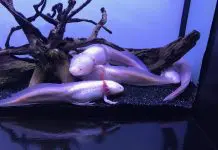
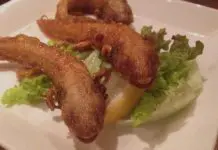
![Sick Axolotl, Fungus, Stress Symptoms [Axolotl Illness Guide 2025] Axolotl fungus](https://exopetguides.com/wp-content/uploads/2018/06/axolotl-218x150.jpg.webp)
